
Callichthyidae is a family of catfishes, called armored catfishes due to the two rows of bony plates along the lengths of their bodies. It contains some of the most popular freshwater aquarium fish, such as many species in the genus Corydoras.

The black neon tetra is a freshwater fish of the characin family (Characidae) of the order Characiformes. It is native to the Paraguay basin of southern Brazil. They are often found in the aquarium trade.

Corydoras is a genus of freshwater catfish in the family Callichthyidae and subfamily Corydoradinae. The species usually have more restricted areas of endemism than other callichthyids, but the area of distribution of the entire genus almost equals the area of distribution of the family, except for Panama where Corydoras is not present. Corydoras species are distributed in South America where they can be found from the east of the Andes to the Atlantic coast, from Trinidad to the Río de la Plata drainage in northern Argentina. Species assigned to Corydoras display a broad diversity of body shapes and coloration. Corydoras are small fish, ranging from 2.5 to 12 cm in SL., and are protected from predators by their body armor and by their sharp, typically venomous spines.

The skunk loach, skunk botia or Hora's loach is a species of botiid loach found in the Mekong River basin in Indochina, as well as the Chao Phraya and Mae Klong basins in Thailand. The maximum size is 10 cm (4 in) and it occurs in water with parameters 26 - 30 °C temperature, pH 6.0 to 8.0, hardness 5.0 to 12.0. It feeds on live crustaceans, insects, snails and other invertebrates.

The bronze corydoras, green corydoras, bronze catfish, lightspot corydoras or wavy catfish is a tropical freshwater fish in the "armored catfish" family, Callichthyidae, often kept in captivity by fish keepers. It is widely distributed in South America on the eastern side of the Andes, from Colombia and Trinidad to the Río de la Plata basin. It was originally described as Hoplosoma aeneum by Theodore Gill in 1858 and has also been referred to as Callichthys aeneus.

Sterba's corydoras is a member of the South American Corydoras genus of freshwater aquarium catfish and one of the most popular species of Corydoras due to its attractive markings. The fish is native to the Guaporé River region between Bolivia and Brazil.
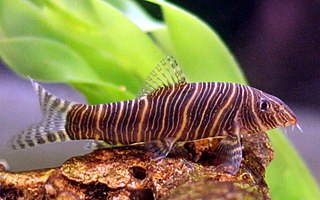
The zebra loach is a freshwater loach native to rivers and streams in the Western Ghats of India. The maximum size is about 9 cm (3.5 in). It lives in tropical climate with temperature range of 21–26 °C (70–79 °F), and prefers water with 6.0 to 7.5 pH.

Corydoras paleatus is a species of catfish of the family Callichthyidae. Its common names include blue leopard corydoras, mottled corydoras, and peppered catfish. It originates from the lower Paraná River basin and coastal rivers in Uruguay and Brazil.

Corydoras panda is a species of catfish belonging to the genus Corydoras, of the family Callichthyidae, and is a native member of the riverine fauna of South America. It is found in Peru and Ecuador, most notably in the Huanaco region, where it inhabits the Rio Aquas, the Rio Amarillae, a tributary of the Rio Pachitea, and the Rio Ucayali river system. The species was first collected by Randolph H. Richards in 1968, and was named Corydoras panda by Nijssen and Isbrücker in 1971. The specific name is an allusion to the appearance of the fish, which possesses large black patches surrounding the eyes, reminiscent of those found on the giant panda. Accordingly, the common names for this fish, which is a popular aquarium species, are panda corydoras and panda catfish.
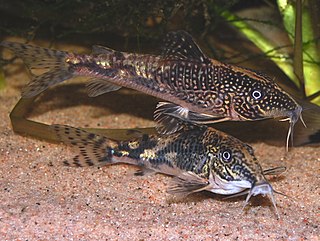
The banded corydoras or bearded catfish is a subtropical freshwater fish belonging to the subfamily Corydoradinae of the family Callichthyidae. It originates in coastal drainages in South America from Rio de Janeiro to Santa Catarina, Brazil.
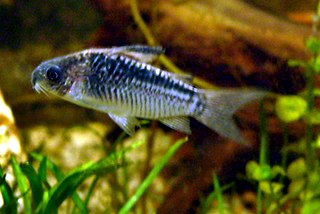
The elegant corydoras or elegant catfish is a tropical freshwater fish belonging to the subfamily Corydoradinae of the family Callichthyidae. It originates in inland waters in South America, and is found in the Upper Amazon River basin in Brazil, Colombia and Peru. The specific epithet elegans means elegant.
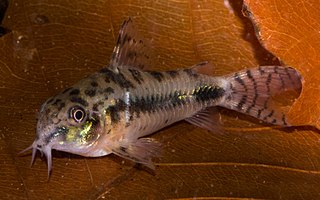
The salt and pepper catfish is a tropical freshwater fish belonging to the Corydoradinae sub-family of the family Callichthyidae. It originates in inland waters in South America, and is found in the Upper Orinoco River basin in Venezuela and Colombia.
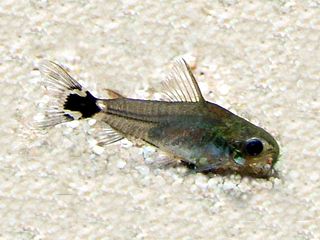
The dwarf corydoras, dwarf catfish, tail spot pygmy catfish, or micro catfish is a tropical freshwater fish belonging to the subfamily Corydoradinae of the family Callichthyidae. It originates in inland waters in South America, and is found in the Amazon River and Paraguay River basins in Argentina, Bolivia, and Brazil. The specific epithet hastatus means with a spear, in reference to the spearhead-like spot on the tail root.
Corydoras nanus is a tropical freshwater fish belonging to the Corydoradinae sub-family of the family Callichthyidae. It originates in inland waters in South America, and is found in the Suriname and Maroni River basins in Suriname and the Iracoubo River basin in French Guiana.
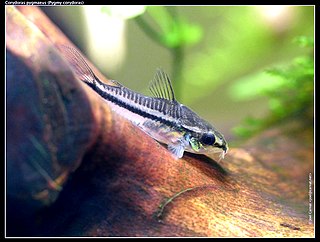
The pygmy corydoras or pygmy catfish is a tropical and freshwater fish belonging to the subfamily Corydoradinae of the family Callichthyidae. It originates in tropical inland waters in South America, and is found in the Madeira River basin in Brazil.
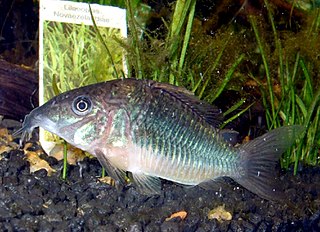
The emerald catfish is a tropical freshwater fish belonging to the Corydoradinae sub-family of the family Callichthyidae native to the Amazon Basin in South America. It has traditionally been known as Brochis splendens. The fish has appeared on a stamp in Brazil.

The golden otocinclus is one of the smallest known suckermouth catfish, often called a 'dwarf oto'. Endemic to Southeast Brazil, this herbivorous, rheophilic, bottom-feeder only grows to around 4 cm (1.6 in) in length. The close relatives of this small fish are often used for the purpose of controlling algae in small home aquariums, under the name Otocinclus affinis. In reality, they belong to the species O. vittatus, O. vestitus and O. macrospilus. The real M. affinis is not present in the aquarium hobby.

Corydoras julii is a small freshwater catfish native to eastern Brazil. It is often confused with Corydoras trilineatus, also known as the three stripe corydoras.
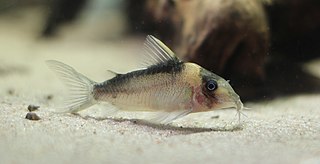
Corydoras imitator is a small species of tropical freshwater armoured catfish native to the Upper Amazon, Solimões, and Rio Negro basins in South America. It was first described by the Dutch icthyologists Han Nijssen and Isaäc J. H. Isbrücker in 1983, and is frequently seen in the aquarium trade.


















